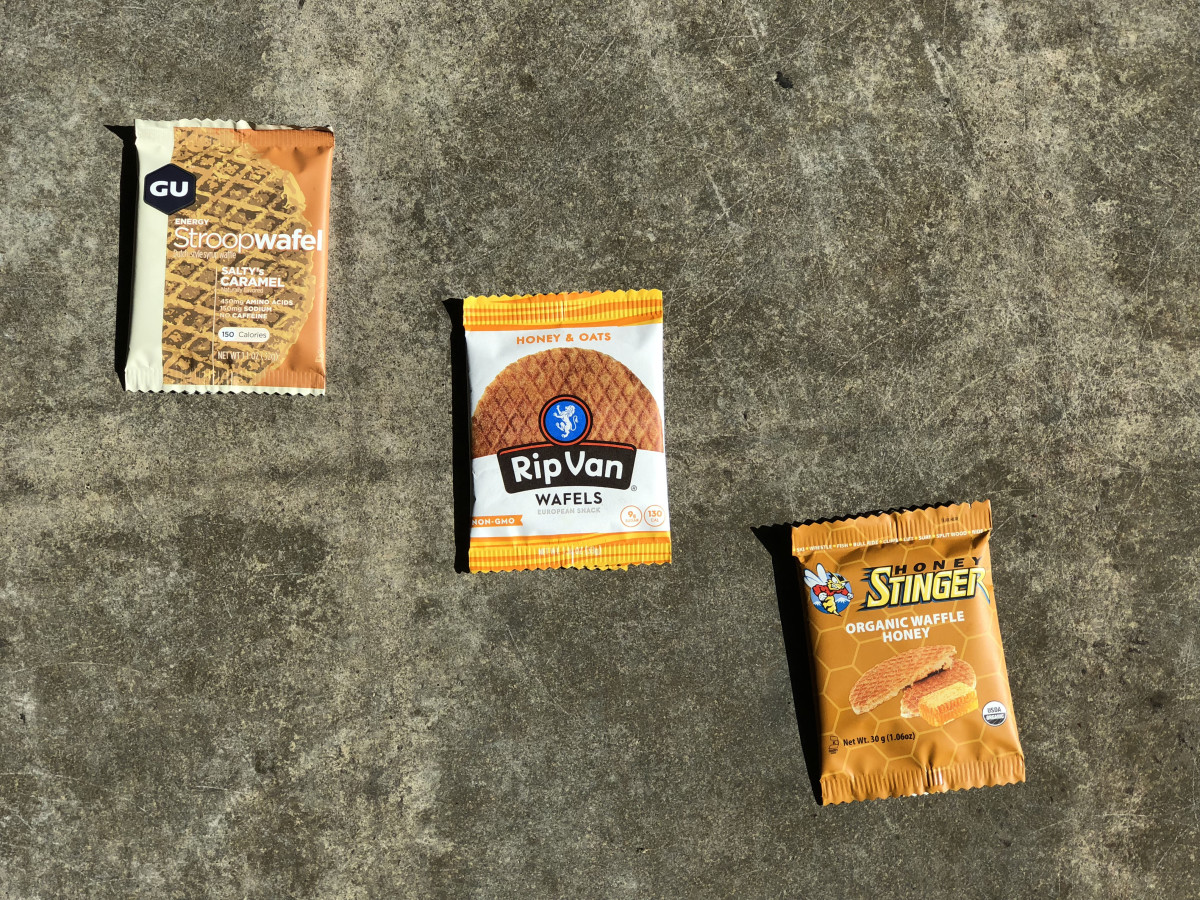If someone asked, “Want an energy waffle?” what would be the first thing that popped into your mind?
A crispy, fluffy Eggo smothered with some questionably healthy, sugar-coma-inducing toppings?
For those not “in the know” on the energy waffle, don’t be bummed. The phenomenon actually started centuries ago in the Netherlands, when bakers in the Dutch town of Gouda began making what they called Stroopwafels—literal translation “syrup waffle”—a hand-pressed treat concocted of sweet syrup made from beet sugar and thin, crisp wafers.

But the small-yet-filling (and interestingly satisfying) treat has only really risen in US markets in recent years, particularly with the active outdoor crowd. Companies like Honey Stinger, GU Energy Labs and Rip Van Wafels, have unleashed the on-the-go snack to the masses; they can even be found in the energy bar section of REI and other stores that cater to outdoor and active lifestyles.
The history of the stroopwafel being used for energy dates back to their adoption by the Belgium bicycling community. Cyclists turned to the stroopwafel, looking for an easy-to-pack, energy-revving option that could be tucked away in a jersey.
While it may seem arbitrary, this tradition is one that’s widely recognized in the region.
“The Dutch are avid cyclists so it makes sense that they picked up on the stroopwafel’s high-carb-to-sugar ratio becoming the perfect fuel-up before or during rides,” says Netherlands native and Rip Van Wafels Co-founder Rip Pruisken. “It can also get to be quite cold in the Netherlands so prior to your ride the traditional way of eating the waffle—warming it on top of a coffee or tea—is also the perfect pre-ride ritual.”

These days, companies competing in the space have subbed out syrups for slightly different, more health-conscious ingredients like honey and tapioca syrup, supporting a sustainable energy release over long periods of time.
What would these companies say to people who think the stroopwafel is just a glorified cookie?
“We’ve got a crazy loyal following of active outdoor athletes that eat our waffles in the morning with coffee or tea, during breaks while they bike or on a hike to help keep energy levels up,” says Honey Stinger Co-owner Len Zanni. “A lot of customers report using them as fuel for marathons and ultra running events or long distance cycling rides.”
The stroopwafel is still a novelty to many, and we were curious to put the different variations to the test.
Taste Test

Rip Van Wafels, launched in 2010 at Brown University through a Kickstarter campaign, is now based in San Francisco. Their mantra is to create convenient food options that are healthier.
In addition to Rip’s, we put waffles to the test from Colorado-based Honey Stinger and Berkeley, California GU Energy Labs.
Honey Stinger has been around for decades, but started putting energy waffles on the market in 2010, with help and inspiration from part-owner and well-known cyclist Lance Armstrong.
Everything Honey Stinger does revolves around (you guessed it) honey. Their waffles have a thicker profile than Rip Van Wafels, and appear to contain more filling when you bite into it.
Honey Stinger has also introduced a gluten-free option for those with certain food restrictions. We had a chance to taste those, and the subtle difference in taste is almost indiscernible.
For this comparison, though, we tasted Honey Stinger’s Organic Honey Waffle. Honey Stinger’s outer wafer tasted less sugary compared to Rip Van Wafels’, while the inner filling had a subtle sweetness to offset this.
Rip Van Wafels’ filling was a thinner layer than Honey Stinger’s, but was more chewy and gooey in consistency.
The GU Stroopwafel had the least chewy consistency of all the fillings, and the outer wafer also seemed to contain a bit more oil to the touch. Though it may just have been indicative of the two flavors we tried—Salty Caramel and Salted Chocolate—GU’s wafels tasted a bit more sodium-heavy than others.
From a pure taste perspective, Honey Stinger and GU tasted more like something we’d bring on the trail, while Rip Van Wafels were equally as delicious, but really tasted more like a treat we wouldn’t feel as bad indulging in.
Our favorite flavor from Rip was a tie between the Chocolate Brownie and the Dutch Caramel and Vanilla. We weren’t a big fan of the Toasted Coconut.
Nutrition Comparison

When discussing energy, it’s common sense to take a look at some of the basic sources, like carbs, sugar, and protein.
Honey Stinger’s waffles contain about 11 grams of sugar and 21 grams of carbs in a serving, which is one, 1-ounce waffle. You are getting 150 calories in a serving, which could power a quick run or longer hike or bike ride.
GU contains 140 calories, and similarly has 10 grams of sugar and 21 grams of carbs.
Rip Van Wafels hover around 8 to 9 grams of sugar depending on the flavor, and contain 18-20 grams of carbs and 130 calories.
Rip Van Wafels also have roughly 8 to 9 grams of “added sugars” in addition to the sugar listed above.
Another thing that stuck out to us about Rip Van Wafels is that one of our favorite flavors, the Chocolate Brownie, contained 155 mg of sodium.
Curious if that was the norm, we took a look at the others, and realized that other Rip Van Wafels flavors and the Organic Honey Waffle from Honey Stingers only contained roughly 55-60 mg of sodium. The two flavors from GU, however, did also contained 150 mg of sodium.

Fat content didn’t fluctuate too much between the different waffles—Honey Stinger with 7 grams, GU with 6 grams, and Rip Van Wafels with 6 grams.
While all of the waffles for this test contain wheat, eggs, and milk, there were ingredient variations to note. Rip Van Wafels’ ingredients are non-GMO verified, and contain chickpea flour and organic tapioca syrup.
Honey Stinger and GU both use organic wheat flour as its main ingredients. Honey Stinger also contains organic rice syrup.
Honey Stinger and GU contain soy flour, something for those with allergies to note.
All three waffle companies use palm oil and cane sugar.
Each contain about 1 gram of protein per serving, and while GU and Honey Stinger are not significant sources of calcium, Rip Van Wafels contains about 2 percent of daily value in one serving.
GU’s flavors contain an amino acid blend of L-Leucine, L-Valine and L-Isoleucine, which set them apart from the others. Upon further research, this combination could help prevent muscle breakdown during active pursuits.
Conclusion
We found each of these waffles really did sustain hunger cravings and energy throughout the day for moderate activity levels, especially if eaten around breakfast with a cup of coffee.
After a few hours, energy levels dip and you need to replenish, especially if taking part in high-intensity activities.
The ease of packaging really does allow for quick snacking just about anywhere, anytime, which helped make us a fan of the energy waffle. Not to mention, they really are indescribably tasty.
Taking both taste and nutrition into consideration, the following would be our recommendations:
Best Overall Flavor: Honey Stinger
Best Chewy, Gooey Consistency: Rip Van Wafel
Best for Sustainable Energy: GU or Honey Stinger
Best Indulgent Treat: Rip Van Wafel’s Chocolate Brownie
Gluten-Free Option: Honey Stinger
from Men's Journal https://ift.tt/30Tj7mo
via IFTTT








0 comments:
Post a Comment